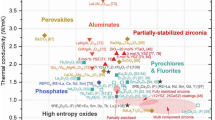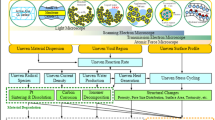Abstract
Combined-cycle power generation is a high-efficiency power generation method using natural gas that can reduce the emissions of carbon dioxide and other harmful substances by increasing the power generation efficiency. Therefore, the turbine inlet temperature should be increased to improve the power generation efficiency. However, given that the operating environment becomes extreme as the turbine inlet temperature increases, ensuring the sufficient durability of the gas turbine components is a necessity. Thermal barrier coatings (TBCs) applied to ensure the durability of the gas turbine components in a high temperature environment can peel off by stress generated through the difference in the thermal expansion coefficient of each layer. Because internal gas turbine components are damaged if peeling occurs, it is essential to ensure sufficient durability of the TBC. In particular, to enhance the efficiency of the combined-cycle power plant, and to withstand higher operating temperatures, it is essential to develop a TBC with an improved durability performance, when compared with currently commercialized TBCs. In this study, we attempted to improve the durability of the TBCs by mitigating the stress concentration phenomenon by gently controlling the rumpling of the oxide layer. For this purpose, the vertical crack design conditions required to reduce the buckling stress were derived through a finite element analysis. Isothermal degradation and thermal fatigue tests were conducted on the fabricated specimens to verify whether the oxide layer rumpling of the designed TBC was controlled gently and whether the durability was improved. Base on the results, a TBC structure with improved durability using oxide layer rumpling control technology is proposed.














Similar content being viewed by others
References
Kotowicz, J., & Brzęczek, M. (2018). Analysis of increasing efficiency of modern combined cycle power plant: A case study. Energy,153, 90–99.
Schmidt, C., Li, W., Thiede, S., Kara, S., & Herrmann, C. (2015). A methodology for customized prediction of energy consumption in manufacturing industries. International Journal of Precision Engineering and Manufacturing-Green Technology,2(2), 163–172.
Lee, J. M., Wee, S. W., Yun, J., Song, H., Kim, Y., Koo, J. M., et al. (2018). Life prediction of in738lc considering creep damage under low cycle fatigue. International Journal of Precision Engineering and Manufacturing-Green Technology,5(2), 311–316.
He, B., Huang, S., & Wang, J. (2015). Product low-carbon design using dynamic programming algorithm. International Journal of Precision Engineering and Manufacturing-Green Technology,2(1), 37–42.
Olumayegun, O., Wang, M., & Kelsall, G. (2016). Closed-cycle gas turbine for power generation: A state-of-the-art review. Fuel,180, 694–717.
Mishra, S. (2018). Energy and exergy analysis of air-film cooled gas turbine cycle: effect of radiative heat transfer on blade coolant requirement. Applied Thermal Engineering,129, 1403–1413.
Pin, L., Ansart, F., Bonino, J. P., Maoult, Y. L., Vidal, V., & Lours, P. (2011). Processing, repairing and cyclic oxidation behaviour of sol-gel thermal barrier coatings. Surface & Coatings Technology,206, 1609–1614.
Kim, D. J., Shin, I. H., Koo, J. M., Seok, C. S., & Lee, T. W. (2010). Failure mechanisms of coin-type plasma-sprayed thermal barrier coatings with thermal fatigue. Surface & Coatings Technology,205, S451–S458.
Song, H., Kim, Y., Lee, J. M., Yun, J., Kim, D. J., Koo, J. M., et al. (2016). Life prediction of thermal barrier coating considering degradation and thermal fatigue. International Journal of Precision Engineering and Manufacturing,17(2), 241–245.
Kim, Y., Lee, J. M., Song, H., Han, K., Koo, J. M., Lee, Y. Z., et al. (2017). TBC Delamination Life Prediction by Stress-Based Delamination Map. International Journal of Precision Engineering and Manufacturing-Green Technology,4(1), 67–72.
Chen, Y., Zhao, X., Bai, M., Yang, L., Li, C., Wang, L., et al. (2017). A mechanistic understanding on rumpling of a NiCoCrAlY bond coat for thermal barrier coating applications. Acta Materialia,128, 31–42.
Evans, A. G., Mumm, D. R., Hutchinson, J. W., Meier, G. H., & Pettit, F. S. (2001). Mechanisms controlling the durability of thermal barrier coatings. Progress in Materials Science,46, 505–553.
Li, G., & Wang, L. S. (2019). Durable TBCs with self-enhanced thermal insulation based on co-design on macro- and microstructure. Applied Surface Science,483, 472–480.
Zhang, H., Sun, J., Duo, S., Zhou, X., Yuan, J., Dong, S., et al. (2019). Thermal and mechanical properties of Ta2O5 doped La2Ce2O7 thermal barrier coatings prepared by atmospheric plasma spraying. Journal of the European Ceramic Society,39, 2379–2388.
Liu, A., & Wei, Y. (2003). Finite element analysis of anti-spallation thermal barrier coatings. Surface & Coatings Technology,165, 154–162.
Kyaw, S., Jones, A., & Hyde, T. (2013). Predicting failure within TBC system: Finite element simulation of stress within TBC system as affected by sintering of APS TBC, geometry of substrate and creep of TGO. Engineering Failure Analysis,27, 150–164.
Evans, A. G., He, M. Y., Suzuki, A., Gigliotti, M., Hazel, B., & Pollock, T. M. (2009). A mechanism governing oxidation-assisted low-cycle fatigue of superalloys. Acta Materialila,57, 2969–2983.
Białas, M. (2008). Finite element analysis of stress distribution in thermal barrier coatings. Surface & Coatings Technology,202, 6002–6010.
Koo, J. M., & Seok, C. S. (2014). Design Technique for Improving the Durability of Top Coating for Thermal Barrier of Gas Turbine. Journal of the Korean Society for Precision Engineering,31(1), 15–20.
Song, H., Moon, B. W., Choi, J., Song, D., Koo, J. M., & Seok, C. S. (2014). Durability evaluation of thermal barrier coating (TBC) according to growth of thermally grown oxide (TGO). Transactions of the Korean Society of Mechanical Engineers A,38(12), 1431–1434.
Ng, H. W., & Gan, Z. (2005). A finite element analysis technique for prediction as-sprayed residual stresses generated by the plasma spray coating process. Finite Elements in Analysis and Design,41, 1235–1254.
Kim, Y., Lee, D., Lee, J. M., Song, H., Kim, S. H., Koo, J. M., et al. (2014). A Study on Thermal fatigue life variation according to thermal exposure time. Applied Mechanics and Materials,598, 276–280.
Song, H., Kim, Y., Yun, J., Seok, C. S., and Koo, J. M. (2015). Evaluation for effect of vertical crack on thermal fatigue life in thermal barrier coating. In: Proceedings of KSPE 2015 Autumn Conference, p. 111.
Acknowledgements
This work was supported by the National Research Foundation of Korea(NRF) grant funded by the Korea government (MSIP) (No. 2015R1A2A1A10055230). This work was supported by the Human Resources Development program (No. 20174030201720) of the Korea Institute of Energy Technology Evaluation and Planning(KETEP) grant funded by the Korea government Ministry of Trade, Industry and Energy.
Author information
Authors and Affiliations
Corresponding author
Additional information
Publisher's Note
Springer Nature remains neutral with regard to jurisdictional claims in published maps and institutional affiliations.
Rights and permissions
About this article
Cite this article
Song, H., Lee, JM., Yun, J. et al. Oxide Layer Rumpling Control Technology for High Efficiency of Eco-Friendly Combined-Cycle Power Generation System. Int. J. of Precis. Eng. and Manuf.-Green Tech. 7, 185–193 (2020). https://doi.org/10.1007/s40684-019-00116-2
Received:
Revised:
Accepted:
Published:
Issue Date:
DOI: https://doi.org/10.1007/s40684-019-00116-2




